Château Latour 2008
Château Latour has released a parcel of their 2008 this morning. It is being offered in the UK at c.£425 per bottle. The factsheet below summarises its key points.

You can download this slide here: Château Latour 2008
Château Latour has released a parcel of their 2008 this morning. It is being offered in the UK at c.£425 per bottle. The factsheet below summarises its key points.

You can download this slide here: Château Latour 2008
Wine Lister recently analysed the Bordeaux 2009 vintage in two parts. The first – a tasting and subsequent selection of top picks by Wine Lister’s founder, Ella Lister, revealed sublime quality across both banks. The second – a two-page analysis of the vintage overall – reveals that alongside top quality, prices of Bordeaux 2009s are high, and it is therefore all the more difficult to find good value, particularly among the left bank’s classified growths.
With this in mind, our Listed: top five blog this week explores the highest-quality Bordeaux fifth growths from the 2009 vintage. Despite the great quality across appellations, all five hail from Pauillac. They are all also Wine Lister Buzz Brands.
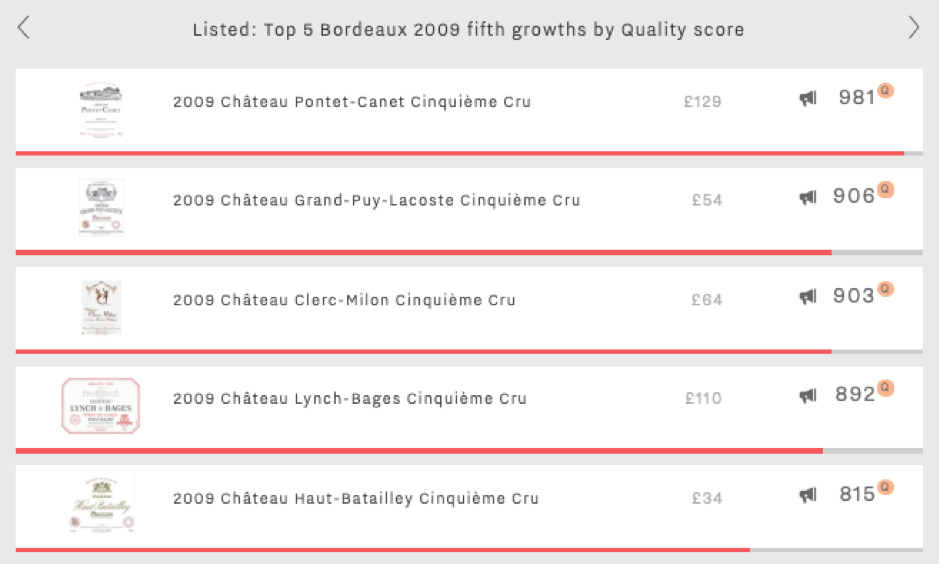
In first place is Pontet-Canet 2009. Its Quality score of 981 sits a full 102 points above the average of the other four wines in this week’s top five. This presumably contributes to its price of £129 per bottle in-bond – the highest of the group.
Next is Grand-Puy-Lacoste 2009, with a Quality score of 906 and the second-lowest price of this week’s top five (£54 per bottle in-bond). It is the only one of the group to appear among top picks from the recent 2009 re-tasting.
Just three points behind Grand-Puy-Lacoste, in third place, is Clerc-Milon 2009. In the economics department it outperforms the rest of the group significantly, with an Economics score of 905 and a compound annual growth rate (CAGR) of 17.3% – over two and a half times higher than the average of the other four wines in this week’s top five.
This week’s last two wines now fall under the same ownership, that of the Cazes Family. Nonetheless, the 2009 vintages of Lynch-Bages and Haut-Batailley, which achieve Quality scores of 892 and 815 respectively, present quite different profiles. Lynch-Bages is this week’s “brand king” with a Brand score of 996 – the highest of this week’s top five – and a price of £110 per bottle in-bond. Though Haut-Batailley 2009 achieves a Quality score 7% lower than Lynch-Bages, its price of £34 is 69% lower than that of its sibling, therefore providing exceptional value. After the acquisition and subsequent repositioning of Haut-Batailley through its 2017 en primeur release, it will be interesting to see how both châteaux fare in the upcoming 2018 campaign.
Wine Lister is experiencing a touch of Bordeaux fever. Having re-tasted Bordeaux 2016s in January, Wine Lister’s founder, Ella, attended BI Wines’ “10 years on” tasting last week, revisiting the iconic 2009 vintage.
As expected, the vintage yielded some truly exceptional wines, thanks to excellent weather conditions, especially around harvest time. However, some producers fell into the trap of waiting too long to pick, and high quality in 2009 is not a given. Ella has picked out 26 of the most successful examples of a unique and pleasure-giving vintage, hailing from across all of the best-known red wine Bordeaux appellations (N.B. no white wines were tasted).
The most heterogenous appellation was Saint-Emilion, with some wines rendered hot and hard by high alcohol, while those at the very top level were some of the best 2009s out there. Cheval Blanc, for example, achieved a “mystical, beguiling bouquet…like a magic potion”.
Pomerol did not seem to suffer from the heat in the same way, and made beautiful wines in 2009. Perhaps unsurprisingly, Le Pin garnered some exceptional comments, including “the richest, most decadent, abundant nose of the whole tasting”. Other Pomerol picks displayed an unusually dark-fruited character. Petrus (“not worn on the sleeve like the Le Pin”), had a “refined dark fruit character”, Hosanna “piercing damson fruit”, and La Conseillante boasted a “carnal, purple-fruit sweetness”.
On the left bank, Pessac-Léognan and Saint-Julien achieve joint-first place, earning five highlights each. Arguably the most impressive of these were La Mission Haut-Brion and Haut-Brion with the former described as “sensual, ethereal, and breath-taking”. Pape Clément showed almost “Rhône-esque animality”, while Malartic-Lagravière was “opulent” and “left you wanting more”.
Saint-Julien presented expected names – second growths Gruaud-Larose and Léoville Barton (described as “ultra-classical” and “thoroughbred” respectively), as well as a surprise in the form of Château Gloria, the only Cru Bourgeois to make it into this list of Bordeaux 2009 tasting highlights.
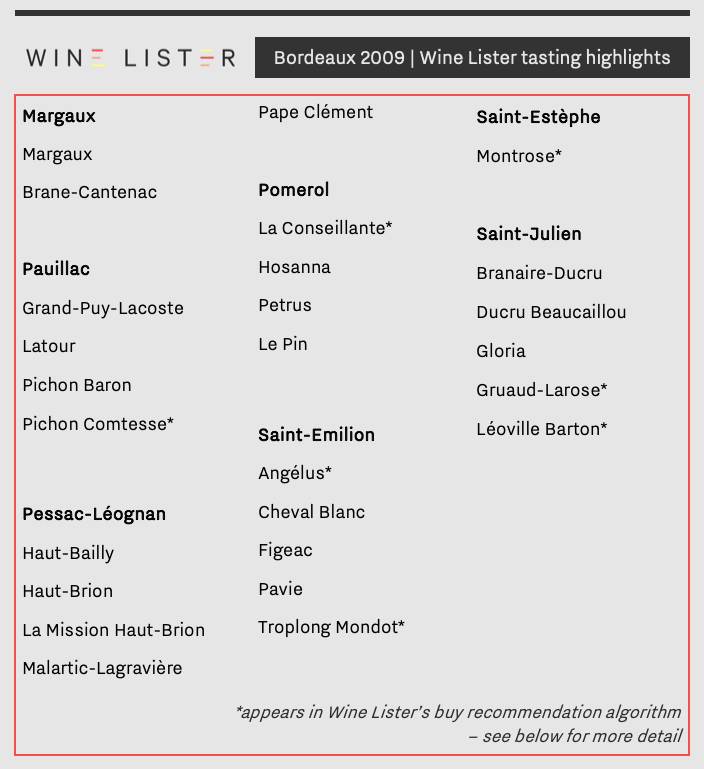
The remaining left bank appellations did not go wanting of favourites. Latour earned the comment, “impeccably turned-out, this wine demands attention”. Elsewhere in Pauillac Pichon Comtesse was “beguiling” and “gradually confident”.
In Margaux the appellation’s first growth namesake was hailed “quite the showstopper”, while Brane-Cantenac was “lifted, lovely, and luminous”. While Saint-Estèphe earned only one mention, its representative, Montrose surpassed expectation, appearing “supremely poised”.
All those wines marked “*” above currently qualify as Wine Lister “buy recommendations”. The Wine Lister team has been working hard to create a data-driven list of the ultimate best wines to buy – watch this space while we fine-tune the algorithm!
Other wines featuring in the Bordeaux 2009 highlights are: Grand-Puy-Lacoste, Pichon Baron, Haut-Bailly, Angélus, Figeac, Pavie, Troplong Mondot, Branaire-Ducru, and Ducru Beaucaillou.
With just over eight weeks to go until Christmas, part of the pre-season ritual of any respectable wine lover is surely agonising over which wines to drink with the holiday meal. Whether that means digging into the cellar or making new purchases, perhaps this week’s top five can provide some inspiration. Since claret is a frequent feature at the Christmas table, this week we consider the best red Bordeaux under £50 by Wine Lister score (although note that prices are based on the per bottle average of in-bond case prices across vintages).
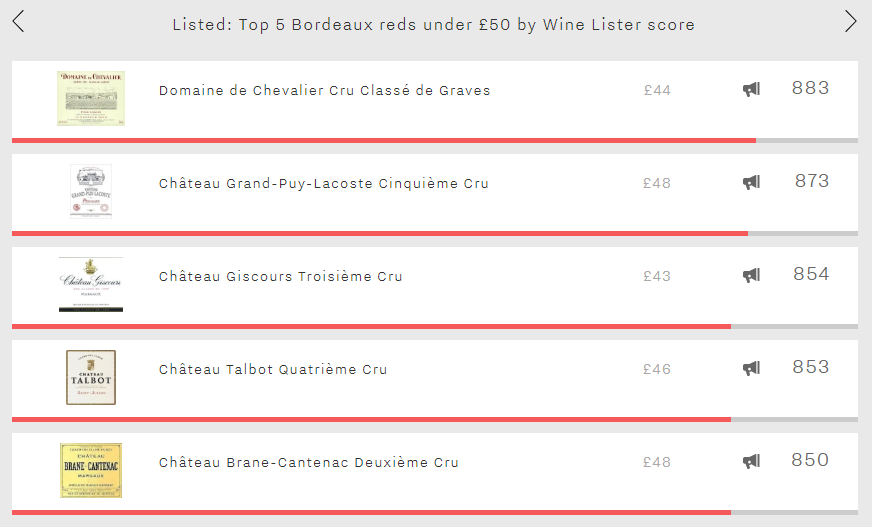
Each of this week’s top five are Buzz Brands, with every wine earning its best score in the Brand category. They also all hail from the left bank, and achieve an average Wine Lister score of 863, 75 points higher than the right bank’s top reds under £50 (788).
First of this week’s top five both overall and for Quality is Domaine de Chevalier, with scores of 883 and 885 respectively, and an average price of £44 per bottle. Though its most qualitative vintage (2015) is only just physical, and therefore not suitable for drinking straight away, there are plenty of vintages around the same in-bond per-case price point to choose from. For example, the 2011 holds a Quality score of 864 and a price of £36, and the 2008 a Quality score of 855 for £40.
Next on the list is Grand-Puy-Lacoste, with a Wine Lister score of 873, and coming in at £48 on average. The 2014 Grand-Puy-Lacoste provides by far the best Quality to price ratio of recent vintages, with a Quality score of 946 and an in-bond per-case price of £41 per bottle. Wine Lister partner critic Neal Martin awards it 95 points, and notes, “the purity and elegance of this Pauillac cannot be denied – a quite brilliant contribution to the 2014 vintage”. This is a wine to give to a loved one for Christmas for them to stow away and open several years down the line – its drinking window ranging from 2022 to 2040.
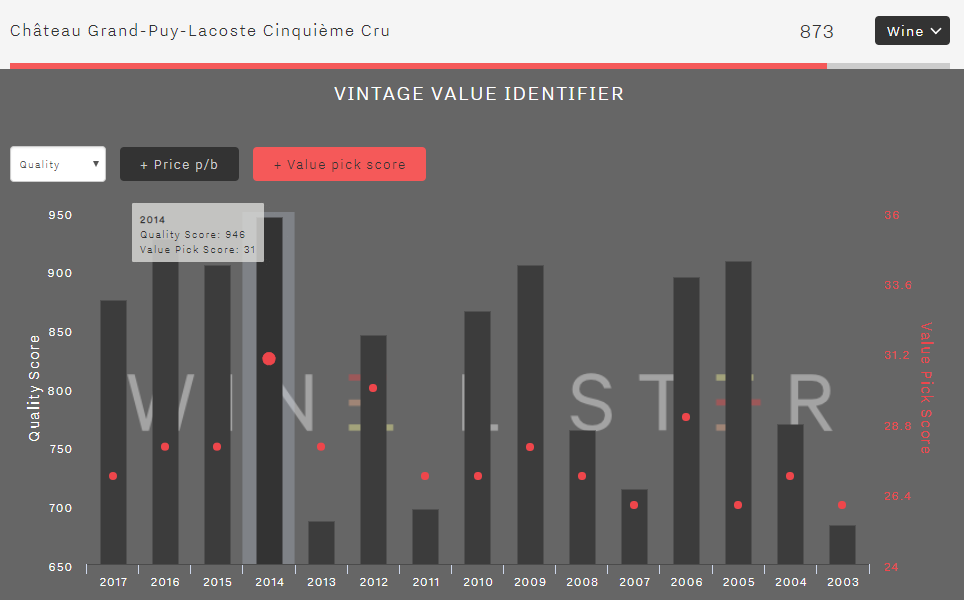 To view quality to price ratios for every wine on Wine Lister, on each wine page use the Value Pick score on Vintage Value Identifier charts, as above.
To view quality to price ratios for every wine on Wine Lister, on each wine page use the Value Pick score on Vintage Value Identifier charts, as above.
Wines three, four, and five of this week’s Listed blog stand within a mere four points of each other. The two Margaux wines to feature, Giscours and Brane-Cantenac, achieve Wine Lister scores of 854 and 850 respectively, and have an identical Quality score (804). However, their profiles differ elsewhere, Brane-Cantenac being the better performer for Economics (806 vs 791), whereas Giscours excels for Brand strength (956 vs 934).
Sandwiched between the two in this week’s top five line-up is Talbot, which claims the group’s highest Brand score (984), if also the lowest Quality score (748), and an average price of £46.
A final commonality of all five wines (and of course of top Bordeaux red as a whole) is the long ageing potential. These five left bank reds have an average drinking window of 13 years, with some more recent vintages expected to be drinking well until beyond 2040 – testament to the tradition of buying claret to lay down for life, and not just for Christmas.
Château Latour has released a parcel of Les Forts de Latour 2009 this morning at €195 per bottle ex-négociant, which will likely result in a UK release price of c.£200. Our factsheet below summarises all the key points.
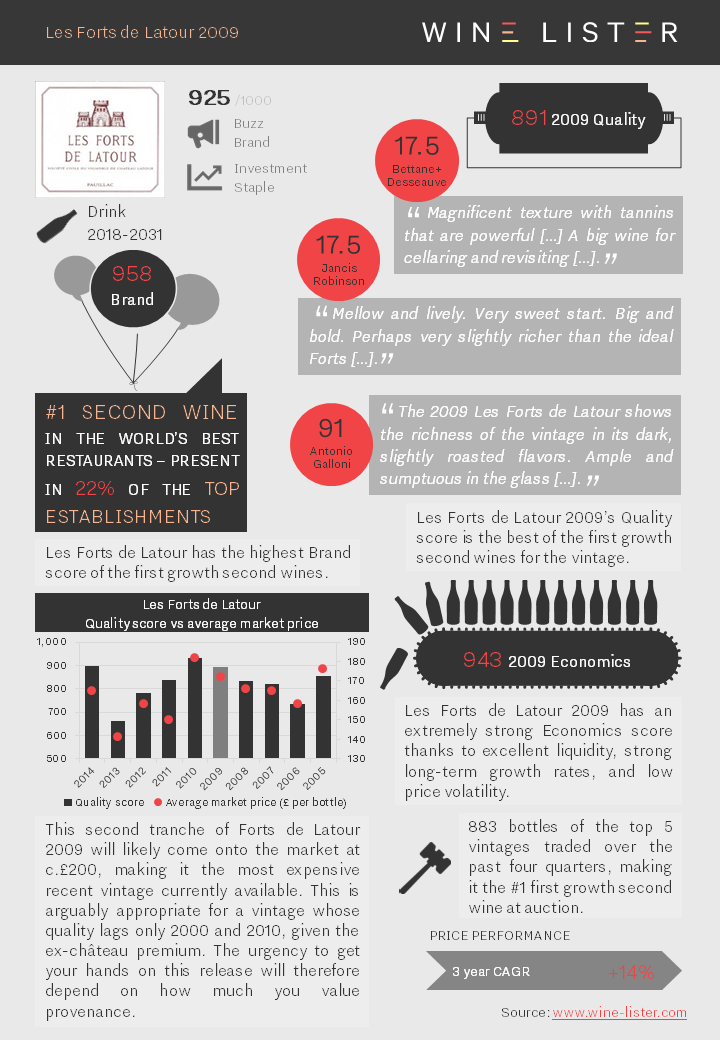
You can download the slide here: Wine Lister Factsheet Les Forts de Latour 2009
Lafite 2017 released at €350 ex-château (8% down on 2016), and is being offered in the UK at £415 (15% down on 2016), with a lower Quality score: 947 (vs 987).
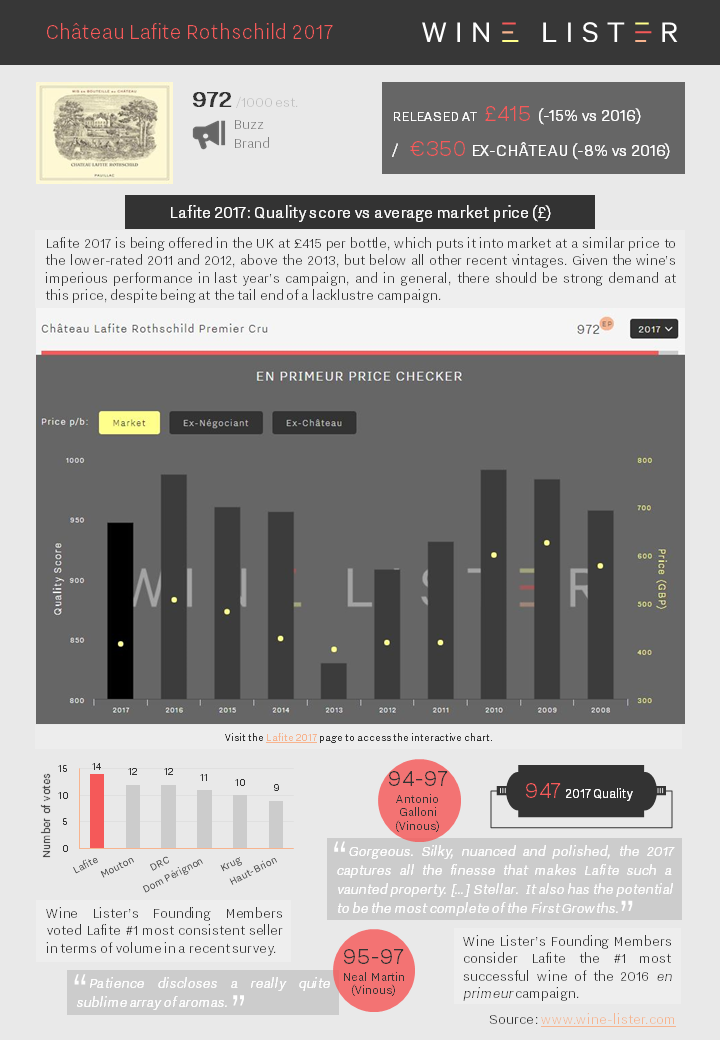
You can download the slide here: Wine Lister Factsheet Lafite Rothschild 2017
Pontet-Canet 2017 released at €80 ex-négociant (26% down on 2016), which will likely result in a UK release price of c.£82 (28% down on 2016), with a lower Quality score: 911 (vs 981).
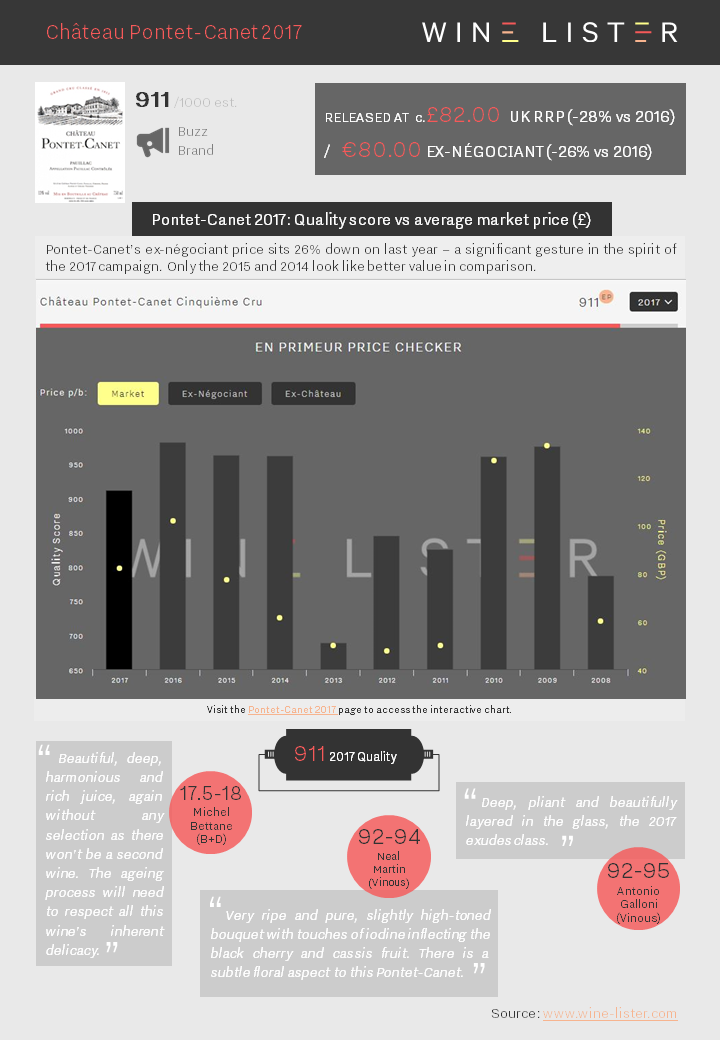
You can download the slide here: Wine Lister Factsheet Pontet-Canet 2017
Le Petit Mouton 2017 released at €144 ex-négociant (9% up on 2016), with a UK release price of £149 (also 9% up on 2016), and a lower Quality score: 846 (vs 926).
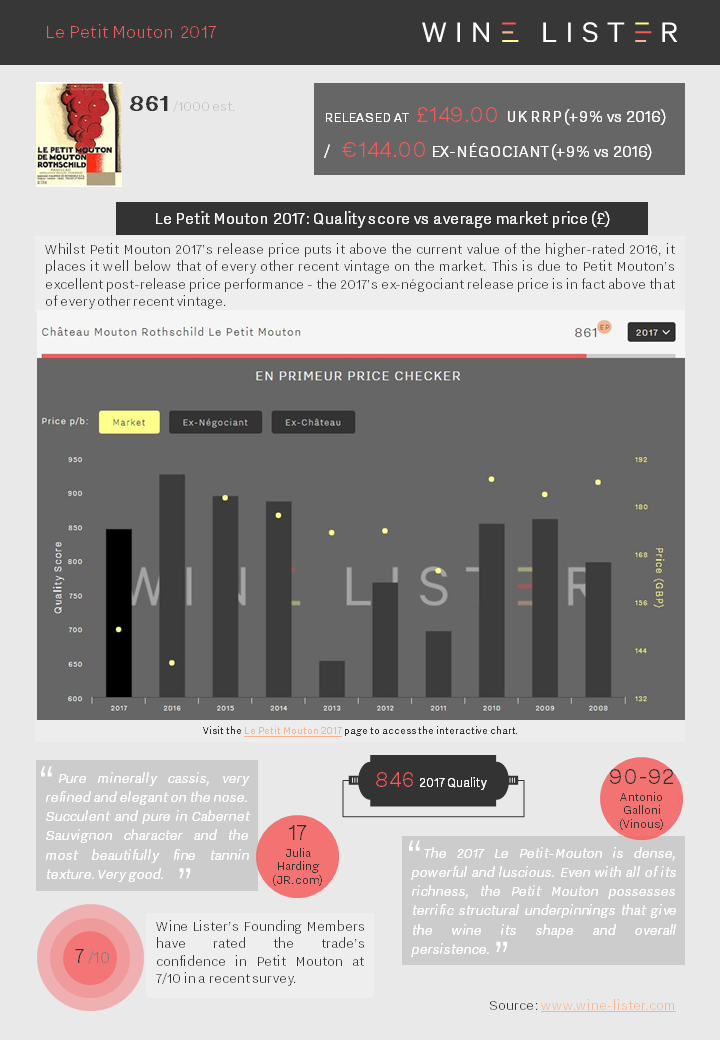
You can download the slide here: Wine Lister Factsheet Le Petit Mouton 2017
Mouton Rothschild 2017 released at €348 ex-négociant (17% down on 2016), with a UK release price of £360 (also 17% down on 2016), and a lower Quality score: 953 (vs 991).
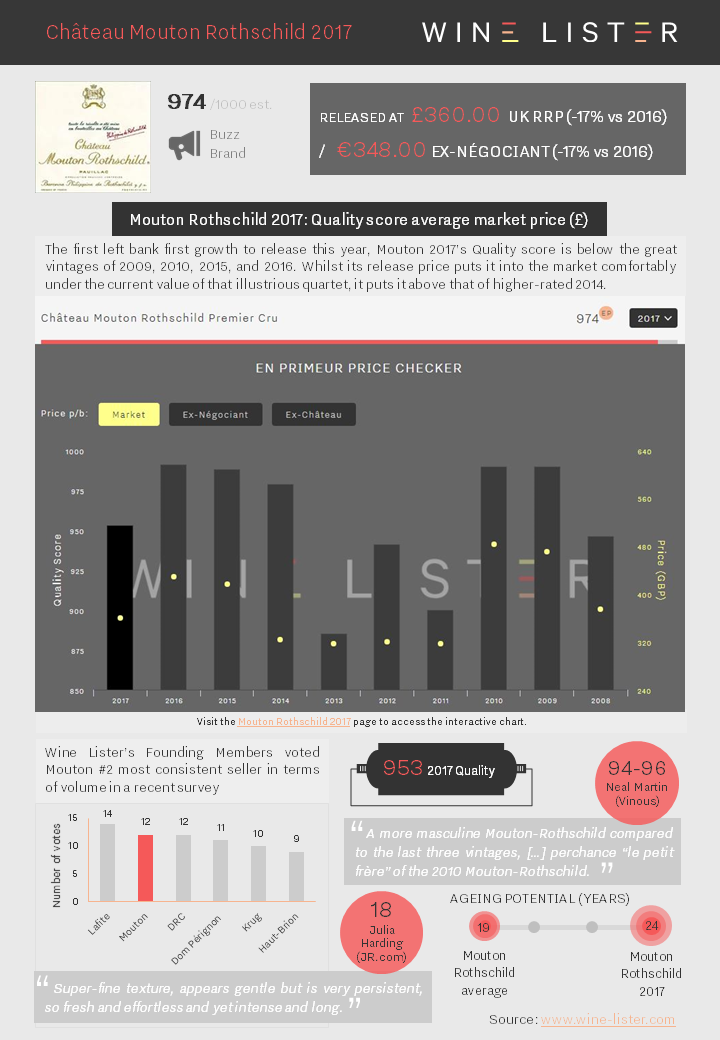
You can download the slide here: Wine Lister Factsheet Mouton Rothschild 2017
Pichon Baron 2017 released at €96 ex-négociant (16% down on 2016), with a UK release price of £98 (13% down on 2016), and a lower Quality score: 936 (vs 979).
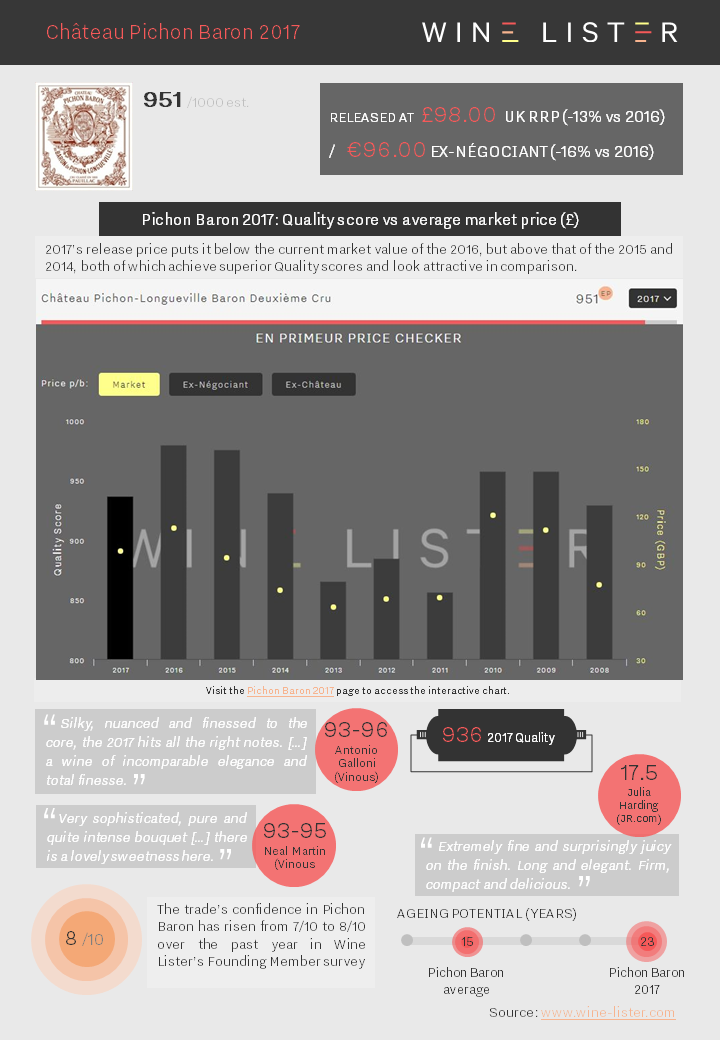
You can download the slide here: Wine Lister Factsheet Pichon Baron 2017